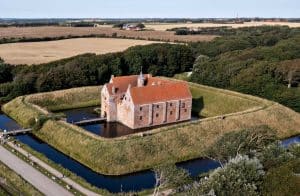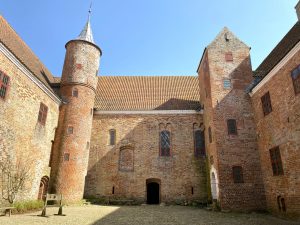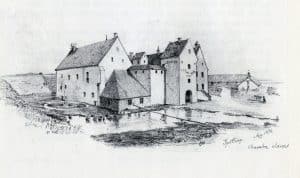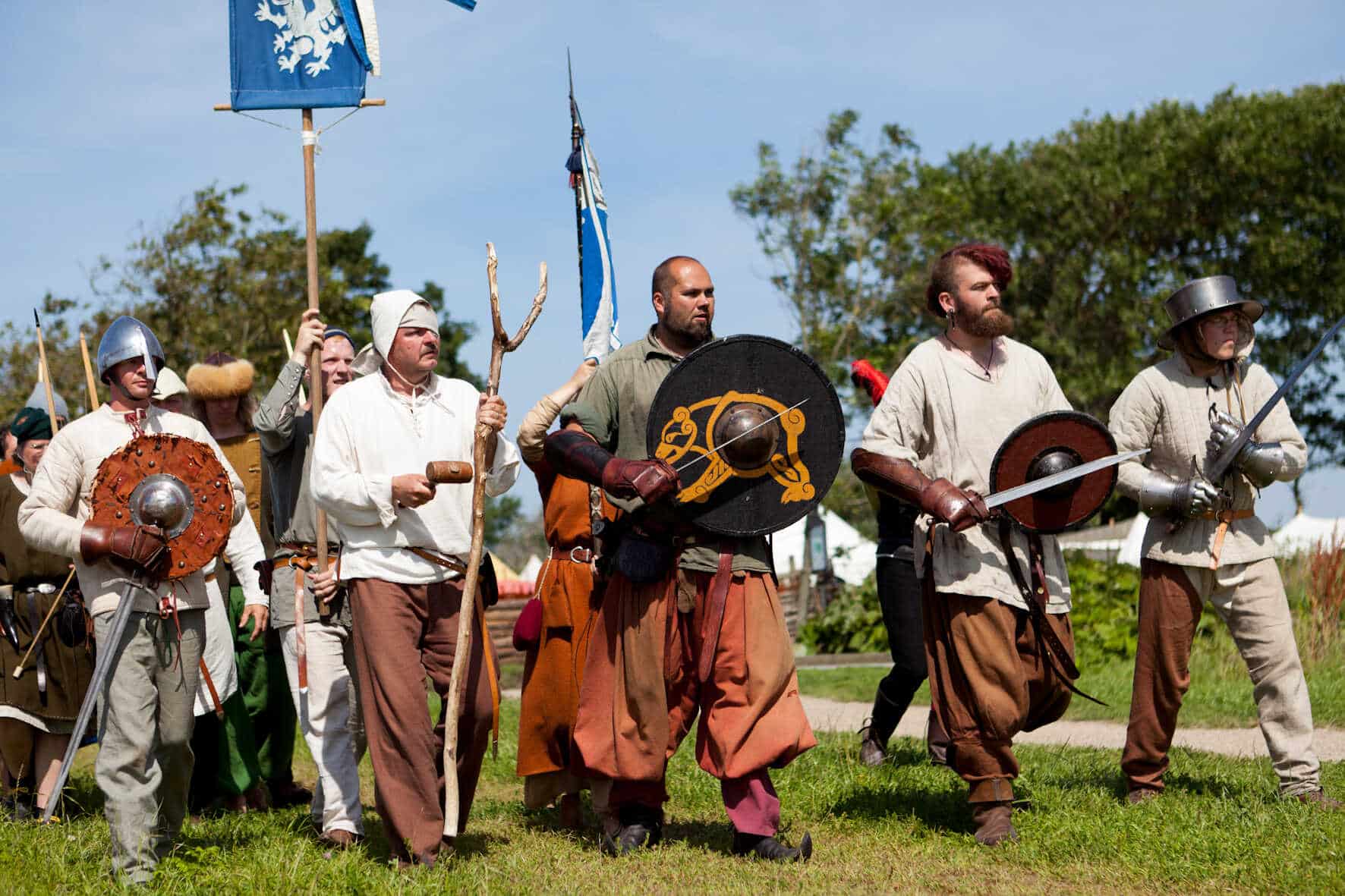MIDDLE AGE
As with so many other castles, fortresses and farms from Denmark’s Middle Ages, Spøttrup’s oldest history is lost in the mists. The first time we hear about Spøttrup in its own right is in 1404, when the knight Johan Skarpenberg granted Viborg Bishopric his farm in Spøttrup – including Spøttrup Lake. After the takeover in 1404, the bishops had their estate in Vestsalling governed by bailiffs who took up residence at Spøttrup.
Apart from the bailiffs’ names, we don’t hear much about Spøttrup in the 1400s, and it’s only when Spøttrup Castle was built that we can say that the land in Spøttrup became more interesting than so many other estates owned by the bishops.
When was Spøttrup Castle built? We don’t know exactly, but with the knowledge we have today about the architectural details of Spøttrup Castle, we can say that the castle must have been completed in the mid-1520s at the latest. This means that it was Bishop Jørgen Friis who completed Spøttrup.
When it was built, Spøttrup Castle was one of the most modern fortresses in the kingdom. The ramparts and double moats were an attempt to keep cannons away from the castle. The cannon was the new, powerful weapon at the end of the Middle Ages. With its exterior works, the double moats and the nine meter high rampart, crowned with palisades and bulwarks, Spøttrup Castle was completed and stood as a powerful fortress with a magnificent residence for the bishop.
But the magnificent residence did not last long: Already in connection with the beginning church struggle between Catholics and Protestants, the large windows on the second floor of the south wing were replaced with bullet holes.

REFORMATION
Viborg was one of the hotbeds of the Reformation in Denmark. That’s why Viborg bishop Jørgen Friis was one of those who suffered when the house of cards fell with the Reformation.
The Reformation ballad began with the Count’s Feud. It is possible that an offshoot of the Count’s Feud caused local farmers to attack Spøttrup Castle, but Skipper Clement himself was not in Spøttrup – and the castle was certainly not burned down, as historian Arild Huitfeldt claims. As we all know, the castle is still there, and without a trace of fire. Rebels may have burned down barns outside the castle, and the attack may have been a later misunderstanding. We do not know.
Shortly after the end of the feud, the king imprisoned the Catholic bishops as part of the Reformation. This included the bishop of Viborg, Jørgen Friis. At the same time as the imprisonments, the king confiscated the church’s goods and property, including Spøttrup Castle.
Spøttrup’s time as a castle was over, because when Spøttrup became royal property, the castle was no longer needed as a defense.
RENOVATION
Henrik Below was a man of a very special stature: He was a nobleman of the new age. Below was born in Klincken in Mecklenburg in 1540. He was both a warrior and a diplomat – and it was precisely these qualities that made him popular with King Frederik II and enabled Below to take over Spøttrup in 1579.
It was a large and unified estate that Below acquired: Spøttrup with 74 farms and four mills in Rødding and Krejbjerg parishes, as well as birch rights over the area.
Fate had been kind to the German immigrant: As the eighth of fourteen children, Henrik Below had no prospect of any significant estates back home in Mecklenburg and a few years after his arrival in Denmark, he was the owner of at least 600 acres.
With Henrik Below, Spøttrup got an owner who considered the castle to be the family home. However, it took a lot of rebuilding to turn the old castle into a stately manor: the two stair towers in the courtyard, the dance hall in the south wing and the demolition of the bishopric’s shuttle roof are all rebuilds that are attributed to Below. This seems to be correct, as timber from the castle’s roof construction is dendrochronologically dated to the mid-1590s, i.e. the time of Henrik Below.
In 1606, Privy Councilor and sheriff Henrik Below of Spøttrup died at the age of 66. And the Below family’s time at Spøttrup ended in 1648.

A TIME OF ENLIGHTENMENT
At the beginning of the 18th century, Spøttrup was by no means at its former strength and dignity. The many years without an owner living in the castle with a sense of reverence for the place had left its mark. At this time, the Spøttrup estate was 279 acres with the barnyard Hesthavegård and Nymølle. It was this estate that the nobleman Axel Rosenkrantz took over in June 1702.
The new owner immediately set about renovating his new home. We can see from the sources that, among other things, considerable amounts of timber were imported.
When Axel Rosenkrantz took over the castle, it was described as “very dilapidated and ruined.” When Bishop Søren Lintrup visited twenty years later, in 1722, however, he described Spøttrup as “very well-built.” Axel Rosenkrantz had thus built a respectable and appropriate home.
In 1724, Axel Rosenkrantz died and left the castle to his son Mogens. Axel Rosenkrantz had lived a quiet life during his 22 years at the castle, and it seemed that his son Mogens intended to do the same. He did not take up a public position until late, when in 1748 he became an assessor in the Supreme Court and later “deputy for the royal finances”.
tHE 1800S
The end of the Great Northern War in 1720 brought peaceful times for an unprecedented period. The country’s economy recovered during the 18th century and brought prosperity to broad strata, including parts of the peasantry. Some peasants even became very rich. One of these was Peder Nissen. He was a farmer from the Ribe region and had made a lot of money from stud farming. In 1784, he bought Spøttrup Castle. However, he died in 1788 and his 17-year-old son Nis had to come home from the Cathedral School where he studied and take over the farm.
These were tough years for the boy: Nis Nissen really had to save to avoid losing his house and home. It wasn’t until around 1820 that he was financially on top. However, the many years of hardship had not left Nissen without a trace. Even in the 1830s, when he was one of the richest men in Jutland, his frugality was so deep that it bordered on the grotesque. There were many stories about the strange, stingy rich man Nis Nissen of Spøttrup; the King of Salling or less reverently: The Steer King.
Nis Nissen left no children. He was married twice. His first wife died in 1824, and the following year he married again – this time to Ane Dorothea Hagensen, 33 years his junior. Like Nissen’s first wife, she was from Mors. Ane gave birth to seven children, but none of them lived beyond the age of two.
Nis Nissen died on July 29, 1848, and as he was childless, his wife and his siblings inherited Nis’ incredible amount of money. A recent study suggests that the fortune of Nis Nissen, the Stud King, is equivalent to the annual salary of 1800 working men in 1849.

MORE RECENT TIMES
After Nis Nissen’s many years at the old castle, a number of owners followed who had less luck with farming in Spøttrup. The castle fell into disrepair and there were more and more demands from outside for a restoration of the castle. This opportunity came when the barn at the castle burned down in 1937. This paved the way for the state to take over Spøttrup Castle.
The government decided to buy Spøttrup Borg and the adjacent land, which was to be parcelled out for smallholdings. The sale price for the manor and the 338 hectares of land was DKK 380,500. The castle itself and almost nine hectares of parkland were to be restored, and the farmland was to be subdivided into 28 smallholdings. Work on restoring the castle continued until 1941.
The castle was partially restored to its original appearance. But not everywhere: Below’s Renaissance conversions, such as the towers in the courtyard and the dance hall in the south wing, were preserved. The architects were of the opinion that it would be too drastic to bring these back, as was Rosenkrantz’s Baroque apartment on the first floor of the south wing. The ramparts and moats were recreated.
The museum at Spøttrup Castle opened to the public on June 15, 1941. More than 2 million people have visited the castle since then.









